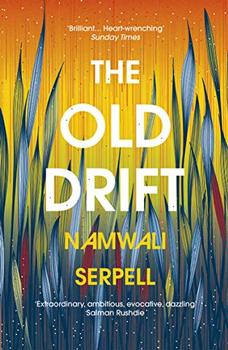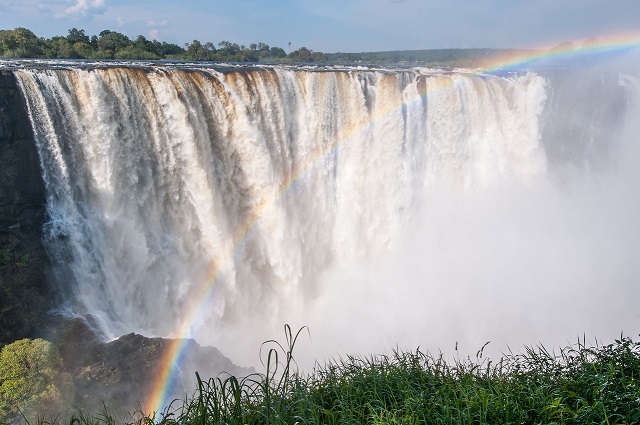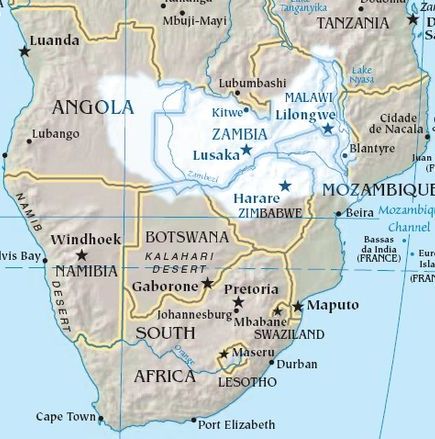Summary | Excerpt | Reading Guide | Reviews | Beyond the Book | Read-Alikes | Genres & Themes | Author Bio

This article relates to The Old Drift
 One of the longest rivers in the world, the Zambezi is fed by many tributaries and flows more than 1,500 miles from the Democratic Republic of the Congo through Angola, Namibia and Botswana, then carves its way through Zambia and Zimbabwe and southeast through Mozambique, ultimately spilling into the Indian Ocean. In some places it's relatively shallow, but in others it is more than 500 feet deep.
One of the longest rivers in the world, the Zambezi is fed by many tributaries and flows more than 1,500 miles from the Democratic Republic of the Congo through Angola, Namibia and Botswana, then carves its way through Zambia and Zimbabwe and southeast through Mozambique, ultimately spilling into the Indian Ocean. In some places it's relatively shallow, but in others it is more than 500 feet deep.
In Namwali Serpell's novel The Old Drift, significant story elements relate to the Zambezi River, a section of which was called "The Drift" during the late 19th century when early European explorers deemed it a relatively easy place to cross compared with more treacherous gorges, rapids or waterfalls. Also mentioned in the novel, European engineers built a hydroelectric dam at Kariba in the 1950s, forming one of Africa's largest freshwater lakes.
The generating capacity of the dam has been expanded over the years. Because of seasonal rainfall changes—and unpredictable impacts of climate change—management of the dam remains complex, shared by Zambia and Zimbabwe. A new dam called the Batoka project has been proposed for the area between Victoria Falls and Kariba. While it will increase hydroelectric power capacity for both countries, critics fear the potential impact on the ecosystem, such as flooding, loss of trees and disruption of wildlife habitats. The Tonga people (and many others) believe that a river spirit, Nyami Nyami, guards the Zambezi. When angered, Nyami Nyami, a snake-dragon-fish entity causes mishaps such as drought, flood or earth tremors. Such disruptions happened during the Kariba Dam construction, and it is feared they could happen again.
 For centuries, the local people have called one particularly spectacular waterfall Mosi-oa-Tunya, which means "The Smoke that Thunders." To the rest of the world it is better known by the name Scottish missionary and explorer David Livingston gave it in 1855. Today, Victoria Falls is considered one of the wonders of the world; the sound of its 300 foot drop can be heard for miles. The town of Victoria Falls provides a convenient location from which to visit the Falls and other nearby sites. It boasts a vibrant tourism scene including opportunities to bungee jump above the river, swim in the Devil's Pool right on the edge of the falls, run the Class V rapids in rubber rafts or kayaks, or observe wildlife (including crocodiles who seem to be waiting for rafts to capsize). Tourists can also cross the Zambezi on the historic steel Victoria Falls Bridge.
For centuries, the local people have called one particularly spectacular waterfall Mosi-oa-Tunya, which means "The Smoke that Thunders." To the rest of the world it is better known by the name Scottish missionary and explorer David Livingston gave it in 1855. Today, Victoria Falls is considered one of the wonders of the world; the sound of its 300 foot drop can be heard for miles. The town of Victoria Falls provides a convenient location from which to visit the Falls and other nearby sites. It boasts a vibrant tourism scene including opportunities to bungee jump above the river, swim in the Devil's Pool right on the edge of the falls, run the Class V rapids in rubber rafts or kayaks, or observe wildlife (including crocodiles who seem to be waiting for rafts to capsize). Tourists can also cross the Zambezi on the historic steel Victoria Falls Bridge.
Between Victoria Falls and Lake Kariba, the Lower Zambezi National Park protects more than 1,500 square miles of wilderness. Wildlife includes elephants, hippos, crocodiles, waterbuck, zebra and more elusive leopard and lion populations. This is a world-class destination for appreciation of wildlife and rare bird species. Fortunately for preservationists, another national park, Mana Pools, is protected on the Zimbabwe side of the Zambezi. Victoria Falls and the Lower Zambezi/Mana Pools National Park regions are both designated as UNESCO World Heritage Sites. Another area of UNESCO interest is the tribal Barotse Cultural Landscape in northwestern Zambia, where traditional village life and cultural practices depend on the vitality of the Zambezi River. However, historic sites and burial grounds are threatened due to seasonal erosion.
A big question for the future is whether the Zambezi can endure the demands of a growing population, endangered wildlife and cross-national competing interests, and remain protected by the legendary Nyami Nyami guardian spirit.
Victoria Falls, courtesy of Everything Everywhere
Filed under Nature and the Environment
![]() This "beyond the book article" relates to The Old Drift. It originally ran in May 2019 and has been updated for the
March 2020 paperback edition.
Go to magazine.
This "beyond the book article" relates to The Old Drift. It originally ran in May 2019 and has been updated for the
March 2020 paperback edition.
Go to magazine.
Your guide toexceptional books
BookBrowse seeks out and recommends the best in contemporary fiction and nonfiction—books that not only engage and entertain but also deepen our understanding of ourselves and the world around us.